#xerxes i
Text

Augustus:
Augustus has also been taken to task for allegedly crying out, when he heard that his fleets were sunk, ‘I will win this war, whatever Neptune may do!’, and for removing the god’s image from the sacred procession at the next celebration of games in the Circus. (Suetonius, Augustus, 16)
Caligula:
In the end, he drew up his army in battle array on the shore of the Ocean and moved the siege engines into position as though he intended to bring the campaign to a close. No one had the least notion what was in his mind, when suddenly he gave the order ‘Gather seashells!’ He referred to the shells as ‘plunder from the sea, due to the Capitol and to the Palatine.’ (Suetonius, Gaius, 46)
Xerxes I:
When Xerxes heard of this, he was very angry and commanded that the Hellespont be whipped with three hundred lashes, and a pair of fetters be thrown into the sea. I have even heard that he sent branders with them to brand the Hellespont. He commanded them while they whipped to utter words outlandish and presumptuous, “Bitter water, our master thus punishes you, because you did him wrong though he had done you none. Xerxes the king will pass over you, whether you want it or not; in accordance with justice no one offers you sacrifice, for you are a turbid and briny river.” He commanded that the sea receive these punishments and that the overseers of the bridge over the Hellespont be beheaded. (Herodotus, Histories, 7.35)
#just emperor things#just roman memes#octavian#caligula#xerxes i#it's entirely possible caligula was screwing with people but augustus was a genuine believer. and genuine blasphemer#my edits#jlrrt speaks
148 notes
·
View notes
Text
Ryu Number: Xerxes I
Xerxes I, also known as Xerxes the Great, was the ruler of the Achaemenid Empire from 486 BCE until his assassination in 465 BCE. At the time of his ascension to the throne, the Achaemenid Empire ran from the eastern end what's now Pakistan to the west end of what's now Turkey. You might notice that that's about the same amount of empire in about the same location as Alexander the Great had—that's because Alexander the Great was the guy who took over the Achaemenid Empire and made it not-so-Achaemenid anymore.
It was awful big, is what I'm saying.
But let's be honest: You probably know Xerxes I better as the Bad Guy with the nose ring in that one weird Spartan hagiography Gerald Butler was in. Fugging Miller.
Anyway, Xerxes I almost certainly has a Ryu Number of 2, and definitely not a Ryu Number more than 3, but there's some stuff.
The problem with finding a Ryu Number of Xerxes I is that 5th-century-BCE Persian monarchs don't show up in video games that often, for some reason. He makes a historical appearance in the Assassin's Creed Odyssey DLC Legacy of the First Blade...
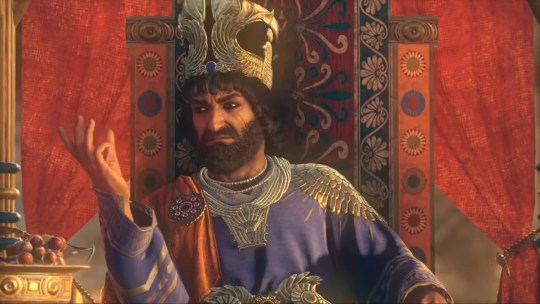
...but unfortunately, Odyssey takes place too far after the times of myth and legend for anyone big enough to be a Minecraft skin in Greek-mythology-inspired DLC to show up.
It doesn't help, either, that in Assassin's Creed lore, all the "gods" were just members of a Precursor Race pretending to be gods, a la Stargate. No, that's not "Hera," that's a jerk Precursor Person who's taken on the identity of "Hera," all the better to lead mankind around like a clowder of schmucks. She's pretending to be Norse elsewhere. Don't fall for it.
(There's also A Minotaur, which feels like it ought to connect via that Minecraft skin pack, but if I'm understanding the Odyssey lore correctly—and I very well might not be; holler at me—the minotaur the player encounters isn't actually the Minotaur from the myth we know and love, but some random other guy who subsequently got his hands on the Precursor Technology that turns you into a minotaur. Yeah, everything is Precursor People in Assassin's Creed. It's kind of disappointing.)
Of course, you can still get to Xerxes through Odyssey if you want to—a handful of historical characters who don't have Minecraft skins show up—but you'll need an extra step. And if we're going to have an extra step anyway, I'm going to go for the route that doesn't need Assassin's Creed, partially because I haven't played the games yet but mostly because I'm still really disappointed about the Precursor People thing.
Which means, unfortunately, it's back to Miller.

I'll say this: For all that 300: March to Glory is Not A Very Good Video Game, it left me the impression that someone behind the scenes actually did the bare minimum research into the Greco-Persian Wars. Persian commanders Hydarnes and Mardonius make appearances (if only to provide something unique to hit), and Mardonius even survives the movie-equivalent events of the game until an epilogic, post-movie level that takes place during the Battle of Plataea—which is, indeed, where the historical Mardonius bit it. It's not much, but I had to watch the whole dang thing, so I'll take what I can get. Gets me more names for The Chart, besides.
As for connecting this game to Ryu, you can, of course, count on the Ol' Dependable of Games With Historical Figures:

...Or maybe you're not a fan of Anime And Things That Look Like Anime, in which case, try this, instead:

I'm not sure I can explain how weird Spartan: Total Warrior is—by which I'm referring to its existence more than anything in the game itself, though the content's pretty weird, too. For context, Total War is a series of strategy games featuring a combination of turn-based strategy, resource management, and real-time tactical control (so sayeth Wikipedia). There are a coupla Warhammer entries in the franchise, sure, but the vast majority of the games focus on real, historical campaigns and factions.
Spartan: Total Warrior, on the other hand, is a hack-and-slash that took one look at a history book and immediately took a pair of shears to it. The story starts in 300 BCE: The Roman Empire, led by Emperor Tiberius, has conquered almost the whole of Greece, with only Sparta remaining, and Leonidas leads his men into battle to oppose him. Later, the Romans reveal a superweapon powered by the imprisoned Medusa. Sejanus, Tiberius' right-hand man, is a powerful necromancer who kills and resurrects Castor's brother Pollux. One mission involves protecting Archimedes, leader of the Athenian resistance, from assassination.
To quote someone on Discord, this is a game supposedly set circa 300 BCE that "has one side led by a king who died 200 years before, and the other by an emperor who reigned 300 years after (never mind the fact that Rome was still a senatorial republic)." If you forced a too-serious historian to play this game they'd end up on the floor in a frothing heap of rage and/or despair (actually, someone should totally do that; I want to see the Greco-Roman history version of Jonathan Ferguson having to analyze the firearms of Team Fortress 2).
Oh yeah and Beowulf is there.
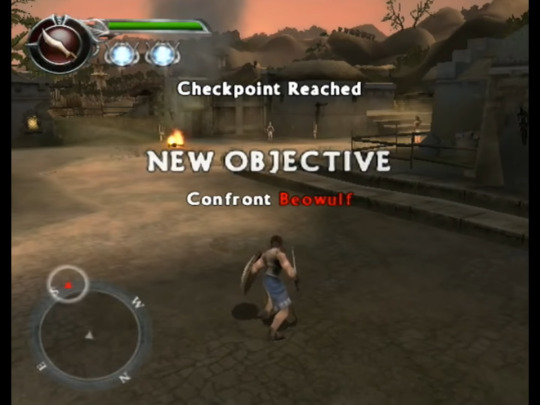
At some point you've got to appreciate—no, admire, even—the Xena:-Warrior-Princess-level decision to just Don't Worry About It.
And now that we have finished with the indisputable, let us proceed with the first of the hinky. Which is to say: Let's look at God of War: Chains of Olympus.
Chains of Olympus begins with an attack by the Persian navy on the Greek Attic peninsula (where Athens is, incidentally). The opening sequence features (among a whole lot of faceless Persian mooks) this prone-ish fella, who doesn't quite get to operating a ballista, irresponsibly leaving the work for Kratos instead.

(Credit: Migeman)
Inspecting the body after all the local ruckus is over identifies him as "Eurybiades," the "leader of the Athenian army."
Eurybiades was—according to historical record—a real person, though God of War doesn't exactly nail it on the head. Herodotus (who historians depend on more due to him being one of a Very Small Number of sources rather than anything to do with actual reliability) names Eurybiades as a Spartan who, during the second Persian invasion of Greece, was given command of the Greek navy due to some political whatuppery (the Spartans said that if a Spartan didn't lead it they'd be Awfully Uncooperative).
Following this bit, Kratos confronts the King of Persia (identity unspecified), who is apparently personally leading the invasion himself, which seems dumb but was apparently the norm back in those days. I bet we'd have a lot less wars if we made our Presidents actually serve on the front lines whenever they started feeling belligerent.

(Credit: Ibid.)
Anyway, Kratos kills the King of Persia, because if the King of Persia killed Kratos the game would be a lot shorter. Now, there's no watertight confirmation that this is the second Persian invasion—the first one also featured attempted Persian inroads into Attica, and was recent enough that it's not inconceivable for Eurybiades to have shown up, there, too—but if this is the second Persian invasion, and that is the King of Persia that was King of Persia during the second Persian invasion, then that King of Persia is Xerxes I.
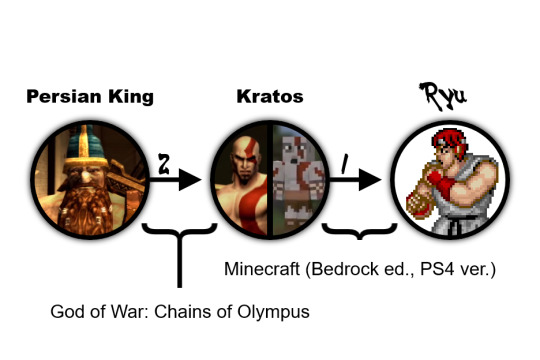

And now, I think, you peer up at me, gaze beseeching. "But KC," you say, anxious and afraid, "Xerxes I didn't die during his invasion of Greece! After Greek victory at the Battle of Salamis, Persian forces were forced to withdraw from Attica, including Xerxes I himself, after which he focused on lavish construction projects until he was assassinated fifteen years later for unrelated reasons! He didn't die in the Greco-Persian Wars at all!"
To which I say: You know who else didn't die in the Greco-Persian Wars? Eurybiades. And you know who definitely didn't die in a fit of paranoid, obsessive overwork in the heart of a monumental statue of Apollo on the isle of Delos?

What I'm saying here is that God of War's relationship with historicality is fleeting at best, so maybe Don't Worry About It here, too.
(Incidentally, if it's the first Persian invasion of Greece that Kratos is mucking around in, then that king is actually Darius the Great, who also didn't die in Greece in real life. Darius is in Civilization V, though, so getting his Ryu Number is a lot easier.)

And speaking of Civilization, I've finally come to the shortest route I've found that, for all its likeliness, isn't as definite as I'd like, which is why I've saved it for last. You know how Civilization works, I think—you play a historical civilization (with a historical leader to match), and go up against other historical civilizations with their leaders. Like Darius, just now—he's your leader if you decide to play as the Persians.
Civilization III is like that...but unfortunately not as much like that as a fellow'd prefer. Sure, it's got its civilizations and leaders...

...But there's the occasional glaring unspecificity that's apparently there to make life difficult for me in particular. Yeah, sure, Montezuma here is most likely the second one—the one everyone knows, the one that had the real bad experience with Spain—but are you sure he isn't the first one instead? Like, absolutely sure? The instruction manual doesn't say, you know. How sure are you? Sure enough to bet a dollar? Two dollars? Fifty dollars? Your firstborn child? Why would I want your firstborn child, anyway? I don't want to look after a child; that's literally more work for me.
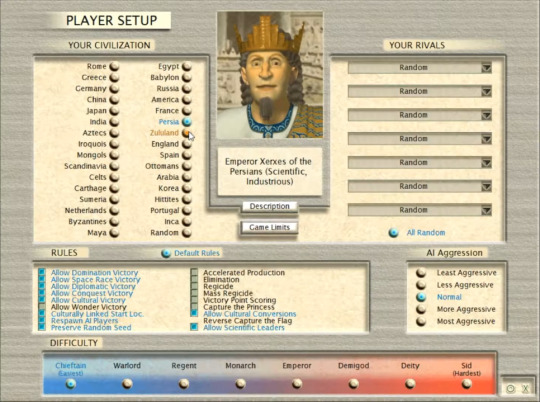
The Persian civilization exhibits the same problem here. Yeah, of course that's Xerxes I! If the team behind the game is picking out a historical figure named Xerxes to represent the Persians, it's got to be Xerxes I. But at the same time, there's technically nothing saying this isn't Xerxes II, a separate 5th-century-BCE Persian ruler of the Achaemenid Empire. I mean, it's terribly unlikely, seeing as Xerxes II ruled for 45 days before being killed by his half-brother, who ruled for six months before being killed by his half-brother, making him Not Exactly The Sort Of Individual You'd Put The Spotlight On, but Mahatma Gandhi and Joan of Arc are the leaders of Indian and French civilizations in this game, and that's weird, too. Gandhi was never the Prime Minister of India or anything like that, and Joan of Arc was a military leader, not a monarch.
Still, if you're willing to follow the reasonable assumption that the Xerxes here is Xerxes I, then the path that results is pretty dang optimal:


...If this is how you found out that Mahatma Gandhi is in Minecraft DLC, I'm sorry.
#ryu number#xerxes i#ryu#namco x capcom#minamoto no yoshitsune#fate/grand order#leonidas i#minecraft#minecraft (bedrock ed.)#ares#spartan: total warrior#minecraft (bedrock ed.#kratos#god of war: chains of olympus#street fighter x tekken#street fighter x tekken (PS3 ver.)#cole macgrath#playstation all-stars battle royale#mahatma gandhi#civilization iii: complete#super smash bros. ultimate#mario#mario's time machine#mario's time machine (SNES ver.)
78 notes
·
View notes
Text
Florence Welch once said "hubris is a bitch" and I, Xerxes the great, really felt that
#tagamemnon#ancient history#xerxes#persian wars#xerxes i#xerxes the great#hellespontus#Herodotus#florence and the machine#Florence welch#music#100 years
78 notes
·
View notes
Text

Esther first appears in the story as one of the young maidens collected into the king’s harem as possible replacements for Vashti, the banished wife of King Ahasuerus (Xerxes I, reigned 485—465 B.C.E.). She is identified as the daughter of Avihail and the cousin and adopted daughter of Mordecai, from the tribe of Benjamin. Not much is revealed about her character, but she is described as beautiful and obedient, and she appears to be pliant and cooperative. She quickly wins the favor of the chief eunuch, Hegai, and, when her turn comes to spend the night with the king, Ahasuerus falls in love with her and makes her his queen. All this takes place while Esther keeps her Jewish identity secret.
After Esther becomes queen, her cousin Mordecai becomes involved in a power struggle with the grand vizier Haman the Agagite, a descendant of an Amalekite king who was an enemy of Israel during the time of King Saul ( Sam 15:32). Mordecai refuses to bow before Haman, and this so infuriates Haman that he resolves not only to put Mordecai to death, but also to slaughter his entire people. He secures the king’s permission to do this, and a date is set, Adar 13 (this episode determines the date of the festival of Purim, a popular Jewish festival). When Mordecai learns of Haman’s plot, he rushes to the palace to inform Esther, weeping and clothed in sackcloth.
#perioddramaedit#history#edit#esther#queen esther#xerxes i#king xerxes#persian history#jewish history#the book of esther#merve bolugur#aesthetic#women of bible#bibleedit#bible women#biblical myth#biblical mythology#bible#biblical#biblicaledit#women of history#biblical women#mordecai#BC#historical women
55 notes
·
View notes
Text
After a 13-year hiatus, the Prince of Persia game series is back in action, with a new game to be released in January. There is a new hero, Sargon, coming to the rescue of the prince. But is there a historic basis to the original ‘Prince of Persia’ character?
#Persia#Royal#King#prince#Rostam#ruler#Achaemenid Empire#Xerxes I#Naqsh-e Rustam#movie#film#ancient#history#ancient origins
16 notes
·
View notes
Text
Legendary Warrior Women of the Ancient World
Once upon a time, there were women who challenged the might of empires and the laws of men.
They beckoned a world where the whisper of a woman's voice could quake the thrones of tyrants.
Let's delve into these legends from antiquity. 🧵⤵️
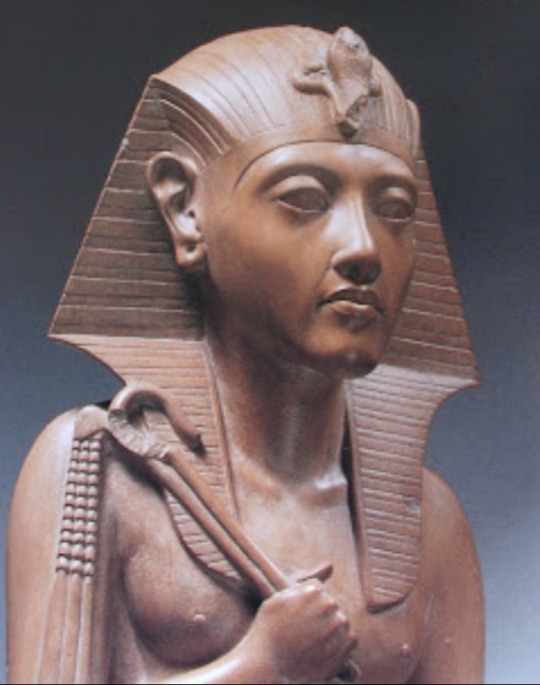
Hatshepsut
The fifth pharaoh of the Eighteenth Dynasty of Egypt, Hatshepsut reigned longer than any other woman of an indigenous Egyptian dynasty.
She was one of the most prolific builders in Ancient Egypt.
To legitimize her reign, Hatshepsut claimed she was divinely conceived by the god Amun, who appeared to her mother in the guise of the pharaoh Thutmose I, her father.
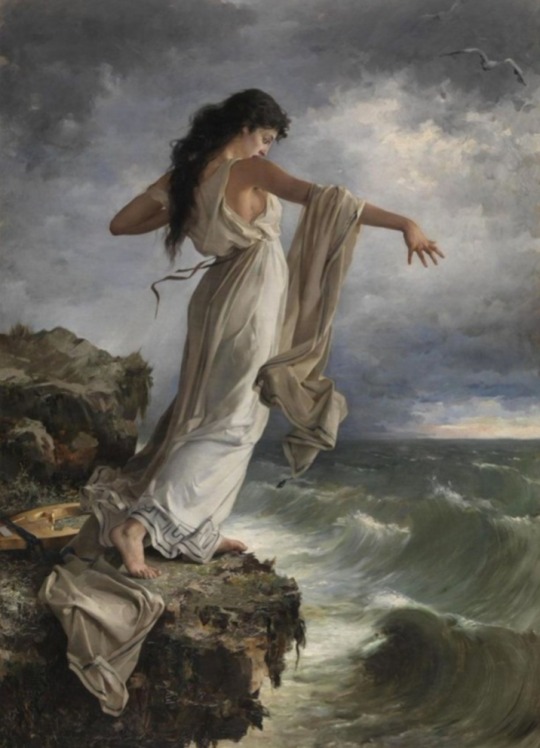
Sappho
An ancient Greek poet from the island of Lesbos, Sappho is celebrated for her lyric poetry, which explores love and passion.
Legend says that Sappho leaped from the Leucadian cliffs due to her unrequited love for Phaon, a ferryman, demonstrating the depth of her emotional expressions that permeated her work.

Artemisia I of Caria
A queen of the ancient Greek city-state of Caria and an ally of Xerxes I during the Second Persian invasion of Greece.
In the Battle of Salamis, Artemisia was so cunning in combat that she intentionally rammed her ally's ship to escape the Greeks, convincing them she was an ally and thus avoiding capture.

Hypatia
A mathematician, astronomer and philosopher in Alexandria, Egypt, Hypatia was a renowned teacher and thinker.
Hypatia was known to drive through Alexandria in her chariot to deliver public lectures on philosophy, defying the gender expectations of her time.
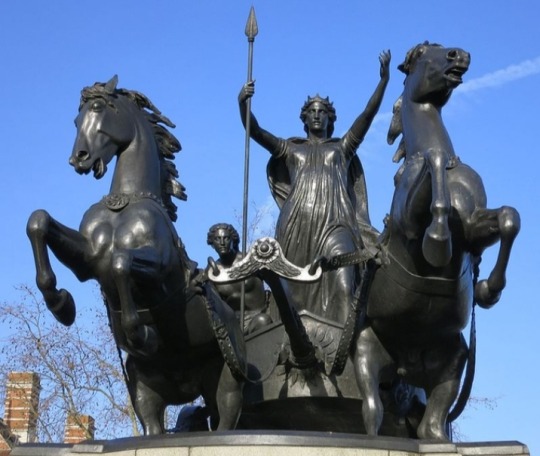
Boudicca
The warrior queen of the Iceni tribe who led a major uprising against the occupying forces of the Roman Empire in Britain.
After the Romans flogged Boudicca and raped her daughters, she rallied her tribe and neighboring tribes for revenge, resulting in the destruction of Roman settlements and the decimation of the Roman Ninth Legion.

The Trung Sisters: Trung Trac and Trung Nhi
Vietnamese military leaders who rebelled against Chinese Han dynasty rule, becoming enduring symbols of resistance.
The sisters, after witnessing the suffering of their people under Chinese rule, famously declared their independence by proclaiming:
"All the male heroes bowed their heads in submission; only the two sisters proudly stood up to avenge the country."

Khawlah bint al-Azwar
A legendary female Muslim warrior, she fought alongside the early Muslims in the battles against the Byzantine Empire.
Khawlah famously donned male warrior’s armor to rescue her brother from a Byzantine prison camp, charging into battle with such ferocity that opponents assumed she was a supernatural entity.

Joan of Arc
A French heroine and saint of the Catholic Church, Joan led French forces to victory over the English at Orléans.
Joan persuaded a skeptical Charles VII of France of her divine mission to save France by correctly predicting a military reversal at the Siege of Orleans, before any messenger could have reached them with the news.

Zenobia
The third-century queen of the Palmyrene Empire in Syria who challenged the authority of the Roman Empire.
Zenobia was so bold that she claimed descent from Cleopatra, positioning herself as the Egyptian queen's successor in defiance of Rome and marched her armies as far as Egypt and Anatolia.
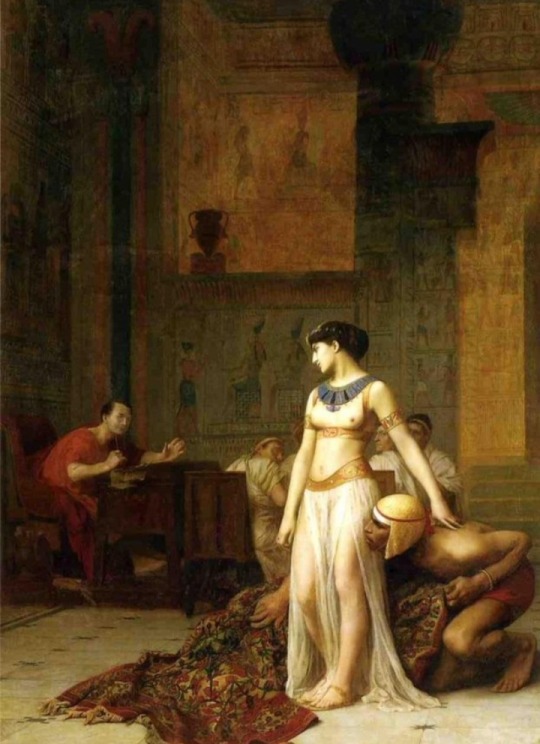
Cleopatra VII
The last active ruler of the Ptolemaic Kingdom of Egypt, Cleopatra is known for her intelligence, political acumen, and dramatic love affairs.
In a famous encounter to secure her alliance with Julius Caesar, Cleopatra had herself wrapped in a carpet (or linen sack, according to some accounts) and delivered to him, emerging to charm Caesar with her wit and beauty.
#female warriors#ancient civilizations#legendary warriors#Hatshepsut#Amun#Thutmose I#Sappho#Phaon#Artemisia I of Caria#Xerxes I#Hypatia#Boudicca#The Trung Sisters: Trung Trac and Trung Nhi#Khawlah bint al-Azwar#Joan of Arc#Charles VII of France#Zenobia#Cleopatra VII#Julius Caesar#ancient empires#ancient world#legends
5 notes
·
View notes
Photo

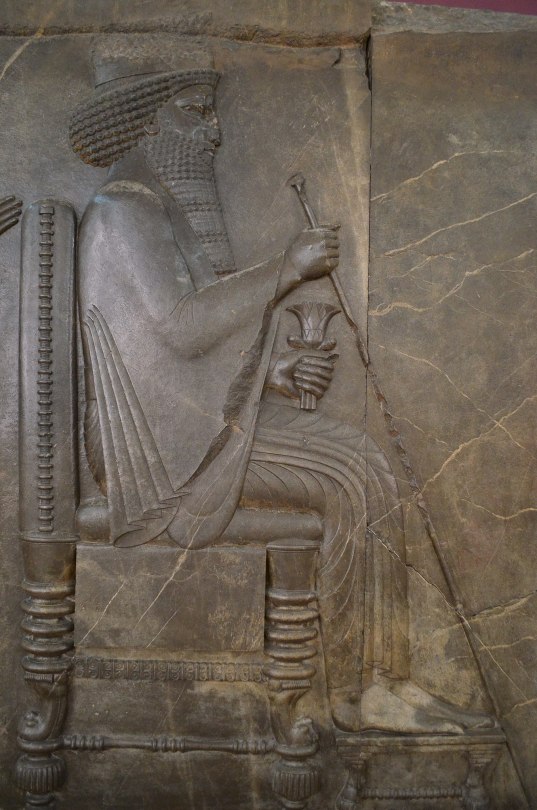
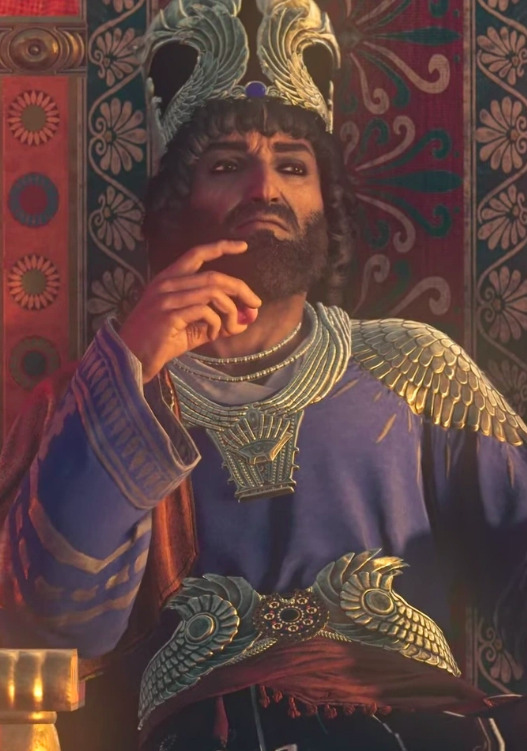

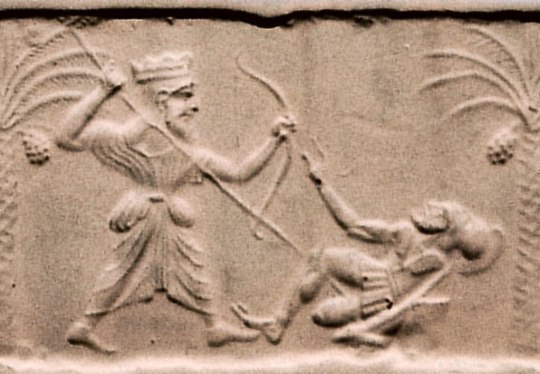
Ahasuerus, Haman and Esther by Rembrandt + National Museum of Iran Darafsh + Xerxes I of Persia + Go by John August (1999) + Achaemenid king killing a Greek hoplite. A possible depiction of Xerxes killing Leonidas
Thus we see how in that ancient Eastern time the Spiritual entered deeply into Nature, into all natural existence. But now we find also among these peoples something which to most of us in the present day may easily appear extremely barbarous. To a man of that time it would have appeared terribly barbarous if someone had been able to write in the feeling and attitude of mind in which we to-day are able to write; it would have seemed positively devilish to him. But when we to-day on the other hand see how it was accepted in those times as something quite natural and as a matter of course that a people should remove from West to East, should conquer — often with great cruelty — another people already in occupation and make slaves of them, then such a thing is bound to appear barbarous to very many of us.
This is, however, broadly speaking, the substance of oriental history over the whole of Asia. Whilst men had as I have described, a high spiritual conception of things, their external history ran its course in a series of conquests and enslavements. Undoubtedly that appears to many people as extremely barbarous. To-day, although wars of aggression do still sometimes occur, men have an uneasy conscience about them. And this is true even of those who support and defend such wars; they are not quite easy in their conscience.
In those times, however, man had a perfectly clear conscience as regards these wars of aggression, he felt that such conquest was willed of the Gods. The longing for peace, the love of peace, that arose later and spread over a large part of Asia, is really the product of a much later civilisation. The acquisition of land by conquest and the enslavement of its population is a salient feature of the early civilisation of Asia. The farther we go back into prehistoric times, the more do we find this kind of conquest going on. The conquests of Xerxes and others of his time were in truth but faint shadows of what went on in earlier ages.
—Rudolf Steiner, World History in the Light of Anthroposophy: Lecture II
After the Greeks had carried on the acquired treasures for some little while, the downfall of Greece occurred, and Rome took her place. In this way we should arrive at a plan of human evolution, so that when speaking of this plan we could never fall into the error of saying: ‘How did it come about, for instance, that just Xerxes or Miltiades or Leonidas had this or that individual karma?’ We must consider this individual karma as something which must be determined by and interwoven with the plan of the evolution of mankind. This cannot be understood in any other way; and this, too, is the view of Spiritual Science. But if this is the case, we must say: In this well-planned advance of human evolution we must see something which is a thing by itself, which is continuous in itself, in a similar way to that in which karmic events in individual human lives are connected with each other, and we must further enquire: ‘What relation does such a plan of the whole evolution of mankind bear to the individual karma of man?’
—Rudolf Steiner, Manifestations of Karma: Lecture XI
If we look with a sensitive eye at the felt relationship between man and man among the Ancient Greeks, and recognize how it has evolved from man's old relationship to the divine, we can say: what was previously an attitude permeated by religion has transformed itself into the legal attitude, the political attitude. Out of this, out of a combination of the nature of Greek and Roman, there then arose something that could maintain itself in social configurations. The priest gradually becomes merely the successor of the Oriental national leaders, for, although he may have kept himself in the background, the priest in the Orient was always the real spiritual leader, even with Darius and Xerxes. There comes to the fore a mode of thinking that cultivates ideas based on the relationship between man and man. And this goes so far that even religious life is swallowed up by this legal current, as I would call it. A juridical element enters man's world-picture, and even the cosmology of the time; and this element then remains almost throughout the Middle Ages and can be detected when we study the political views of, say, Augustine or Aquinas. Religious impulses themselves, while remaining what they are, take on legal forms.
—Rudolf Steiner, The Tension Between East and West: Lecture II
See more on the Kököchin–Barsine-Grail Knight individuality.
#Xerxes I#Xerxes the Great#Ahasuerus#The Book of Esther#Rembrandt#Assassin's Creed#Ancient Persia#Old Testament#spiritual science#anthroposophy#John August#Go (1999)#Sarah Polley#Kököchin#Barsine#the holy grail
4 notes
·
View notes
Text
The Fake Texts of Ancient Greek 'Historians': the Behistun Inscription, Ctesias, Diodorus Siculus, Darius I the Great, and Semiramis
In a previous article published under the title 'Aristotle as Historical Forgery, the Western World’s Fake History & Rotten Foundations, and Prof. Jin Canrong’s Astute Comments', I wholeheartedly supported the position taken by the prominent Chinese Prof. Jin Canrong about Aristotle and I explained why Aristotle never existed as he is known today and most of his texts were not written by him, but by the pseudo-Christian Benedictine monks of Western Europe for the purpose of the ferocious imperial and theological battle that Rome carried out against New Rome-Constantinople and the Eastern Roman Empire. You can find the table of contents and a link to the publication at the end of the present article.

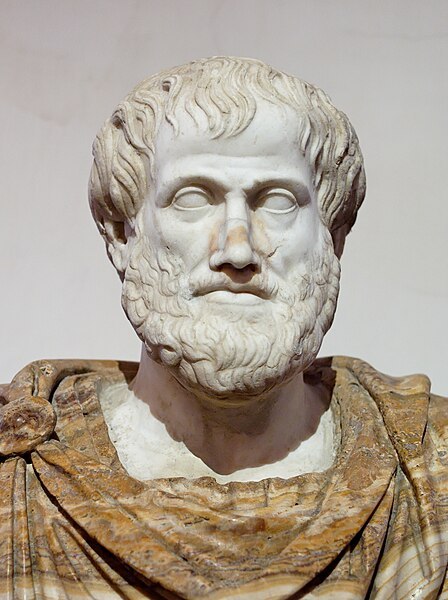
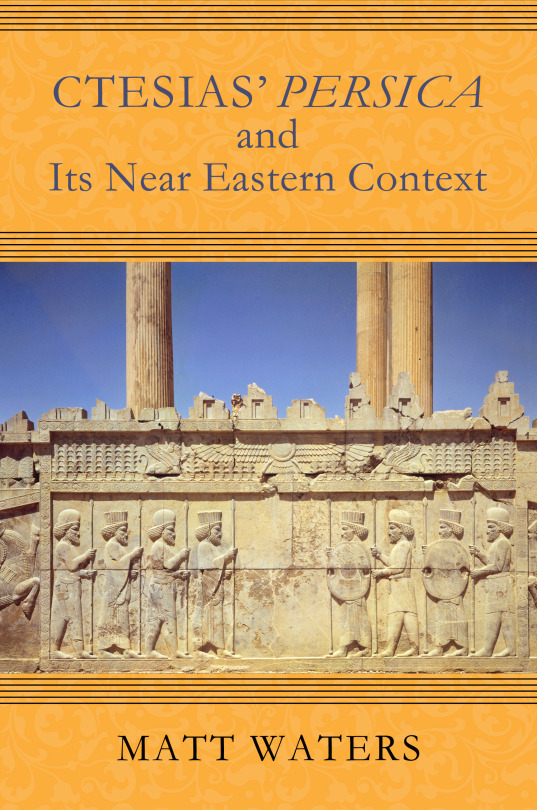
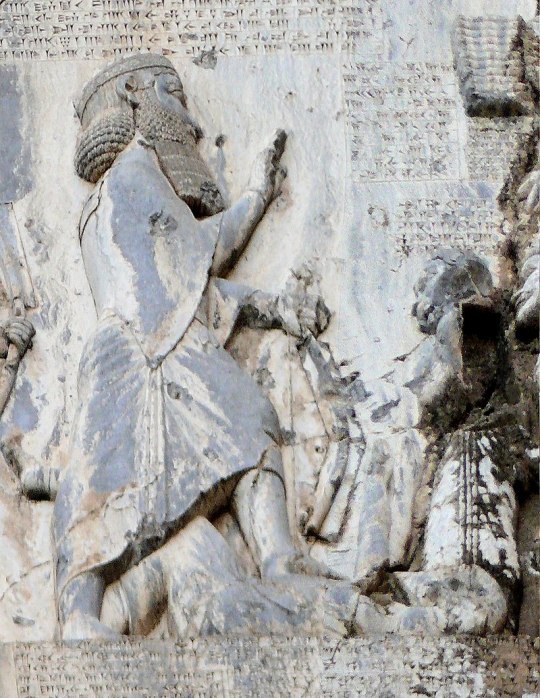
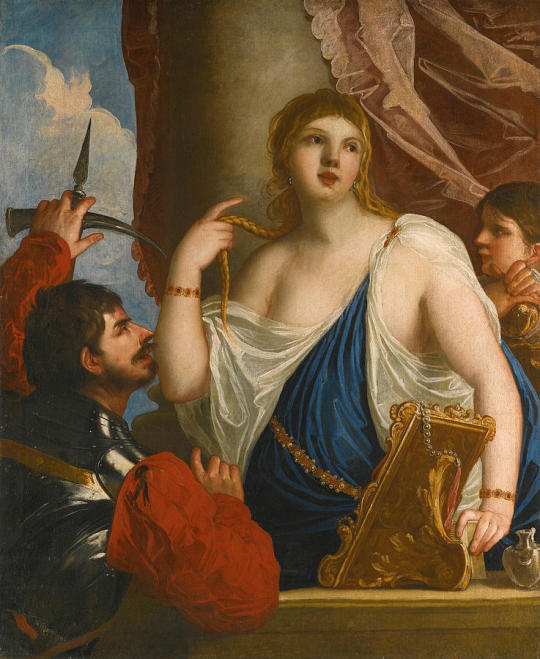
Contents
Introduction
I. A fictional concept: the origin of the fraud
II. A construct based on posterior textual sources
III. The deceitful presentation
IV. 5th century BCE texts found in 15th c. CE manuscripts do not make 'History'.
V. Abundant evidence of lies and deliberate distortions attested in the manuscript transmission
VI. Darius I the Great, the Behistun inscription, and Ctesias
VII. The historical Assyrian Queen Shammuramat and the fictional Queen Semiramis of the 'Ancient Greek sources'
VIII. The malignant intentions of the Benedictine liars: from the historical Darius I the Great to the fictional Semiramis
IX. The vicious distortions of the Benedictine liars: from Ctesias to Herodotus
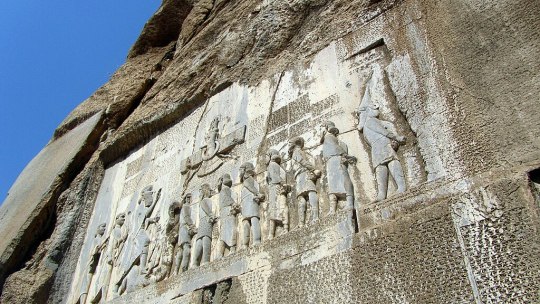
The Behistun inscription
Introduction
In the present article, I will offer a typical example of text falsification carried out by the Catholic monks, who did not 'copy and preserve' manuscripts of ancient Greek and Latin texts, as it has been mendaciously said by Western European and North American academics and lying scholars, but they purposefully falsified, distorted, concealed, destroyed and/or contrived numerous texts.
This enormous forgery took place in Western Europe between the 2nd half of the 8th century and the 1st half of the 15th century; the colonial era was launched exactly afterwards. For this reason, few manuscripts with Ancient Greek and Roman texts date before the 8th c.; in fact, most of them have been either distorted and replaced or hidden in the vast libraries still owned, controlled and administered that the anti-Christian Roman Catholic Church.
The purpose of this devious and evil effort was the fabrication of a fake narrative about the forged antiquity and the supposed importance of the Western Europeans according to the needs of world conquest, prevalence and preponderance of the pseudo-Christian Roman Catholic Church; this bogus-historical dogma, as direct opposition to and ultimate rejection of Orthodox Christianity, would be initially imposed as the 'scientific discipline of History' in Western Europe and subsequently projected onto the rest of the world by means of colonial invasion, indigenous identity destruction, moral integrity demolition, cultural heritage disintegration, educational subordination, economic exploitation, military subjugation, and socio-political domination.
In other words, the monastical scribes and copyists created an entirely fake Euro-centric past, which became the rotten foundation of Western Europe. This fallacy became known as Judeo-Christian world and Greco-Roman civilization. However, the decipherment of ancient languages (Egyptian hieroglyphic, Old Achaemenid Iranian, Assyrian-Babylonian, Sumerian, Hurrian, Hittite, Urartu, Ugaritic, etc) and the study of millions of original texts, which were not copies of earlier sources but contemporaneous to the events that they narrated, sounded the death knell of the era of history fabrication programs.
With the post-Soviet rise of the great continental powers (China, India, Russia, etc.), the economic-military-political-ideological-educational-academic-cultural tyranny of the Western World started being overthrown throughout the earlier colonized world. The historical forgery that the colonial rulers imposed collapsed, the falsehood of the Eurocentric dogma of World History started being revealed and rejected, and an overwhelming project of total de-Westernization appeared as a prerequisite for the liberation of the Mankind from the lies of the European Renaissance, the Western Humanities, the White Supremacism, the Western European colonialism and racism, as well as from the falsehood of numerous subsystems of the construct, such as Classicism, Hellenism, Orientalism, etc.
In our days, it is imperative for anti-colonial scholars to unveil the distortions applied to Ancient Greek and Latin texts by the medieval monks. Consequently, historians from all over the world have to work together in order to denounce and obliterate the Western fraud and the fake History of the Western Man, which consists in arbitrarily taking 14th c. CE manuscripts as authentic narratives of Ancient History.
I. A fictional concept: the origin of the fraud
Apparently, the present brief article cannot be an exhaustive presentation of the Western fraud, and of the historical forgery that the Western monks, manuscript copyists, collectors, academics and propagandists attempted to impose worldwide through colonial conquests, massacres and tyrannies. However, I can still enumerate the major founding myths of the Western World.
Two thematic circles of historical distortions and fraudulent claims made by the Western academia revolve around the following two entirely fabricated entities, which have conventionally but erroneously been called
a) "the Greco-Roman world" and
b) "Biblical Israel" and "Judeo-Christian civilization".
These ahistorical entities never existed. The original concept of those notions is purely fictional, and it therefore remains always unquestioned in the fraudulent Western universities. In this regard, the sources that the Western academics evoke to support their claims are posterior, untrustworthy, forged and therefore worthless.
At times, some of those texts represent merely ancient authors' misperceptions of earlier texts and authors; however, more often, the ancient texts have been tampered with. On other occasions, ancient texts that refute the lies of other historical sources are hidden from the general public and conventionally discussed among the Western academic accomplices.
II. A construct based on posterior textual sources
The entire construct hinges on the deceitful presentation of several types of material forged, collected, concealed, interpreted, contextualized, narrated, repeatedly but intentionally discussed, supposedly questioned, and selectively popularized; this was due to the fact that the said material was incessantly utilized for the colonial needs and targets of the Western European powers (England, France, Holland, Spain, Portugal, and more recently the US). In fact, the Western World's fake History was created as the ultimate support of all colonial claims.
This process happened within a system in which posterior textual sources (preserved in medieval manuscripts) have occupied the central position, whereas the ancient epigraphic material, which was contemporaneous to the historical events under study, has been deliberately disregarded.
All later discovered data and pieces of information were either adjusted to the construct or methodically hidden; this is how the original concept, pathetically believed almost as a religious dogma, remained totally unchallenged down to our days.
III. The deceitful presentation
The quintessence of the deceitful presentation involves a vicious trick; people (pupils and students, but also scholars and intellectuals, as well as the general public) are taught and made accustomed to care mainly about the absolutely insignificant dates of birth and death of historical persons (authors, rulers, etc.), and not about the dates of the manuscripts in which these individuals are mentioned as supposed authors; this situation turns readers, students and scholars into pathetic idiots.
Subsequently, we cannot seriously afford to describe Herodotus as a 5th c. BCE writer, because there is no manuscript with texts attributed to him, dating before the 10th c. CE. In addition, if we take into account the enormous number of other ancient authors decrying, denigrating and rejecting Herodotus' absurdities and malignancy, we have to permanently and irrevocably obliterate Herodotus from the History of Mankind and consider his false, paranoid and racist texts as a double Crime against the Mankind:
first, with respect to the original narrative (to which we don't have access as it was distorted by medieval monastical scribes and copyists) because the author attempted to disparage the superior Iranian civilization and the majestic Achaemenid universalist empire, while undeservedly praising the South Balkan barbarians, and
second, as regards the currently available text, which was forged as per the discriminatory intentions of the monks who altered and distorted it in their effort to fabricate the fake, modern divide (or dichotomy) East-West, and to offer a shred of historicity to it.
IV. 5th century BCE texts found in 15th c. CE manuscripts do not make 'History'.
People get therefore addicted to considering as a true and original 'work' (of an ancient author) the manuscript (or manuscripts) in which the specific treatise, essay or book was copied perhaps 10 or 15 centuries after the author composed it. Due to a long chain of intermediaries (namely library copyists, librarians, scholars, monks, collectors, purchasers and/or statesmen), the transmitted text may have been partly or totally changed.
There is absolutely no guarantee as regards the honesty, the good intentions, the unbiased attitude, and the benevolent character of the perhaps 5, 10, 20 or 50 persons who -living in different eras and without knowing one another- may have constituted the chain of (unknown to us) intermediaries between the hand of the author and that of the last copyist whose manuscript was preserved down to our times.
Example: very little matters today whether the ancient author Diodorus Siculus or Siceliotes (西西里的狄奧多羅斯) actually lived in the 1st c. BCE or in the 3rd c. CE; quite contrarily, what is important for history-writing is the fact that the earliest known manuscript of his famous 'Bibliotheca Historica' (世界史) dates back to the 10th c. CE.
Consequently, the first piece of information that should be stated after the name of any 'ancient' Anatolian, Macedonian, Thracian, Greek, Roman and other author is the date of the earliest extant manuscript of his works.
V. Abundant evidence of lies and deliberate distortions attested in the manuscript transmission
An extraordinarily high number of original sources excavated in Mesopotamia, Egypt, Anatolia, Canaan, Iran and elsewhere, and subsequently deciphered, can be dated with accuracy; example: the Annals of great Assyrian emperor Tiglath-pileser III (745-727 BCE) were written during his reign. They are contemporaneous and therefore original.
However, in striking contrast to them, almost all the manuscripts with the works of ancient Greek and Roman authors whose texts have formed the backbone of the fraudulent historical dogma of the Western academia are not contemporaneous but posterior by, at times, 1500 or 2000 years.
Even worse, numerous ancient Greek authors' texts were not preserved through a manuscript tradition at all; they were saved as references in posterior authors' works. This concerns, for instance, Ctesias (克特西亞斯), an Ancient Carian (Anatolian) physician and erudite scholar, who lived and worked in the court of the Achaemenid Iranian emperor Artaxerxes II in the 5th c. BCE.
Later, willing to offer potential guidebooks to Iran and India for the use of various peripheral peoples and tribes of the Balkan region, Ctesias elaborated in Ancient Ionian (愛奧尼亞希臘語) two treatises to describe the state of things in Iran and in India. To the Western academic bibliography, his works are known (in Latin) as 'Persica' and 'Indica'.
These texts were not saved integrally in manuscripts copied for the purpose of preserving Ctesias' works, but they were preserved in Diodorus Siculus' 'Bibliotheca Historica'. Although he is not known through authentic and contemporaneous Iranian sources, we can deduce that Ctesias certainly spoke fluently the official language of the Empire and read Old Achaemenid cuneiform. Eventually, he may have also studied and learned Babylonian and Elamite cuneiform, namely two ancient Mesopotamian cuneiform languages and writings the use of which was maintained by Iranian scribes.
Apparently, Ctesias had a firsthand insight, as he lived for many years in Parsa (Persepolis), the capital of the Achaemenid Empire and he also traveled extensively along with the Iranian emperor. But, unfortunately, the following ordeal was produced.
VI. Darius I the Great, the Behistun inscription, and Ctesias
One century before Ctesias served Artaxerxes II, the empire of Iran was saved by Darius I the Great (大流士一世; reign: 522-486), who overthrew a usurper, namely the Mithraic (密特拉教祭司) magus Gaumata (高墨达), and by so doing, preserved on the throne a dynasty of faithful Zoroastrian (瑣羅亞斯德教徒) monarchs.
To commemorate his great victory and the consolidation of the his dynasty, Darius I the Great had an enormous rock relief and a monumental inscription (貝希斯敦銘文) engraved on the rocks of Mount Behistun (貝希斯頓山), at a distance of 150 km west of Hamadan (哈马丹; Ekbatana/埃克巴坦那) in Western Iran (15 m high by 25 m wide and 100 m up the cliff). As it can be easily understood, these events occurred after the assassination of Cambyses, at the very beginning of Darius I the Great's reign.
It goes without saying that the successors of Darius I the Great and the imperial Iranian administration knew perfectly well the historical details and were fully aware of the imperial inscription that immortalized the event, which had obviously become the cornerstone of the imperial education.
VII. The historical Assyrian Queen Shammuramat and the fictional Queen Semiramis of the 'Ancient Greek sources'
However, one century later, when Ctesias lived in Iran, served the Iranian Emperor, and spoke Old Achaemenid Iranian (and if not, he was surrounded by the Empire's top interpreters and advisers), something disastrously odd 'happened'.
According to Diodorus Siculus, who explicitly stated that he extensively quoted from Ctesias' text (Bibliotheca Historica, II 13), the imperial Carian physician and author appears to have attributed the Behistun inscription and the rock reliefs to none else than the Assyrian Queen Shammuramat (薩穆-拉瑪特), who was the queen consort of the Assyrian Emperor Shamshi Adad V (沙姆什·阿達德五世; reign: 824-811) and co-regent (811-805) during the first years of reign of her son Adad Nirari III (阿达德尼拉里三世; reign: 811-783)!
Furthermore, in the 'Ancient Greek' text of Diodorus Siculus, the monumental inscription was said to be written in Assyrian cuneiform (Συρίοις γράμμασιν)! Even worse, in the same text (as preserved today), it was also stated that, in the rock relief, there was also a representation of the Assyrian queen!
Ctesias' text, as preserved by Diodorus Siculus, is truly abundant in information, but it is historically impossible and therefore entirely forged. Due to this and many other texts, an enormous chasm was unnecessarily formed between
a) the historical queen Shammuramat of Assyria, whose historicity is firmly undeniable, due to the existence of several contemporaneous cuneiform sources excavated in Assyria, and subsequently deciphered and published,
and
b) the purely fictional Assyrian queen Semiramis (沙米拉姆) of the posterior Ancient Greek textual sources that were supposedly 'preserved' (but in reality deliberately distorted and forged) in the Benedictine manuscripts of Western Europe's monasteries.
However, if we examine closely the facts, we will surely understand what truly occurred in this case; then, we will be able to fathom how the fake History of the Western world was fabricated.
The Behistun inscription is trilingual, as it was written in Old Achaemenid Iranian (the earliest form of written Iranian languages), Babylonian, and Elamite; this was a very common practice during the Achaemenid times (550-330 BCE). The main figure of the associated rock relief is Darius I the Great, evidently the representation of a male royal.
One way or another, with respect to the Behistun inscription and rock relief, Ctesias certainly knew everything that we know today after the successive decipherments of the Old Achaemenid, Babylonian and Elamite cuneiform writings, or perhaps even more, due to the then extant oral tradition.
VIII. The malignant intentions of the Benedictine liars: from the historical Darius I the Great to the fictional Semiramis
The Behistun inscription is not Assyrian; the representation is not that of female royal; and the monument is totally unrelated to Shammuramat, who had lived 300 years before Darius I the Great and 400 years before Artaxerxes II's physician Ctesias. More importantly, by that time, the Assyrian Empire did not occupy the lands surrounding Behistun. Accompanied by Iranian imperial officers and his associates, Ctesias certainly learned all the details of the monumental inscription that we can now read in articles, courses, lectures, books and encyclopedias.
The narrative was a triumph for Darius I the Great and a spectacular rebuttal of the vicious Mithraic Magi who had supported the defeated evil sorcerer and villain Gaumata. Apparently, writing a guidebook for Iran to help marginal people of the Empire's Balkan periphery, Ctesias did not have any reason to say lies. Moreover, we don't have any reason to believe that Diodorus Siculus needed to distort the truth to that extent, when copying and thus preserving Ctesias' masterpiece for the posterity.
However, the transmission of the details about the Behistun inscription embarrassed the Benedictine copyists who wanted to denigrate Darius I the Great and to portray his great empire in a most derogatory manner. They had already proceeded in this manner, distorting other manuscripts, forging texts, and fabricating their pseudo-historical narratives at will.
That is why Ctesias' pertinent text, which had certainly been preserved in its original form within Diodorus Siculus' Bibliotheca Historica, was intentionally distorted by the Benedictine 'Holy Inquisition of Libraries', which fabricated the myths of today's Western world some time after the middle of the 8th c. CE. To be accurate, Ctesias' historical description was entirely replaced by a fictional and historically nonsensical account.
The unbelievable lies -invented and included in Diodorus Siculus' quotations from Ctesias- risked making of the fictional queen Semiramis a world ruler! Whereas the Assyrian Empire at the end of the 9th c. BCE did not control even the western half of today's Iranian territory, the unequivocally mythicized Semiramis had supposedly sent her armies up to India where those fictitious Assyrian soldiers were trampled by the elephants. This worthless narrative that replaced Ctesias' original text may very well have been invented as a 'historical' excuse for Alexander the Great's failure to advance deep inside India.
IX. The vicious distortions of the Benedictine liars: from Ctesias to Herodotus
But if the fictional Semiramis' Indian campaign is entirely false, so are then the preposterous narratives of Herodotus about Darius I the Great's and Xerxes I the Great's campaigns in the insignificant and barbarian circumference of South Balkans. These texts involved evil purposes, heinous anti-Iranian biases, fictional battles, racist discourses, vicious lies, incredibly large number of the Iranian armies, and absurdly high number of Iranian casualties.
The mendacious but idiotic Benedictine monks, who wrote those slander tales did not apparently expect that, sometime in the future, excavations would bring to light splendid Iranian antiquities, original cuneiform documentation, and trustworthy contemporaneous historical sources, whereas a systematic effort of decipherment would offer to people all over the world direct access to historical texts written in dead languages, thus irrevocably canceling Herodotus' nonsensical report and, even more importantly, the later distortions that the Benedictine monks made on their worthless manuscripts.
In any case, had those fictional campaigns against 'Greece' had a shred of truth to them, they would have certainly been documented one way or another in various Old Achaemenid, Babylonian, Elamite, Imperial Aramaic, Egyptian hieroglyphic or other sources; but they were not.
Even worse, the meaningless and ludicrous battles of Marathon, Thermopylae, Salamis, and their likes would have been commemorated by the Seleucids, the Ptolemies, and the Attalids all the way down to the Romans and the Eastern Romans. But we know quite well that the nonexistent, fictional past of the so-called Ancient Greek world was absolutely irrelevant to them: precisely because it had not yet been fabricated.
===================
Aristotle as Historical Forgery, the Western World’s Fake History & Rotten Foundations, and Prof. Jin Canrong’s Astute Comments
Contents
I. Aristotle: a Major Founding Myth of the Western World
II. When, where and by whom was the Myth of Aristotle fabricated?
III. The Myth of Aristotle and its first Byproducts: Scholasticism, East-West Schism, the Crusades & the Sack of Constantinople (1204)
IV. Aristotelization: First Stage of the Westernization and the Colonization of the World
V. Aristotelization as Foundation of all the Western Forgeries: the so-called Judeo-Christian Heritage and the Fraud of Greco-Roman Civilization
VI. The Modern Western World as Disruption of History
VII. The Myth of Aristotle and the Monstrosity of Western Colonialism
======================
Download the article in PDF:
#Ctesias#Diodorus Siculus#Behistun Inscription#iran#Achaemenid#Behistun#Bisotun#Darius I the Great#Gaumata#Mithraism#Zoroastrianism#Ahura Mazda#Mithra#Xerxes I#Herodotus#Ancient Greeks#manuscript transmission#Shamshi Adad V#Adad Nirari III#Shammuramat#Semiramis#Benedictines#Renaissance#Classicism#Classics#Orientalism#Hellenism
1 note
·
View note
Text
Aeschylus – Persae, 820
ὡς οὐχ ὑπέρφευ θνητὸν ὄντα χρὴ φρονεῖν.
Ὕβρις γὰρ ἐξανθοῦσ' ἐκάρπωσεν στάχυν
ἄτης, ὅθεν πάγκλαυτον ἐξαμᾷ θέρος.
[LAT] Non debere eum, qui homo sit, nimis elato animo se extollere. Insolentia enim efflorescens progenuit spicam noxae, unde illa (insolentia) lacrimosam messem messuit.
[HIS] Que un mortal no ha de engreír mucho su espíritu. El florecer de la insolencia hace que germine la espiga de la ruina, y recoge lamentable cosecha.
#Aeschylus#Αἰσχύλος#Persae#Πέρσαι#saec. V a.Ch.n.#460 a.Ch.n.#scriptum#tragoedia#Graece#Darius#Darius I#Rex#Persia#Xerxes#Xerxes I
0 notes
Text
#13 Book of Esther
Esther was married to Xerxes I – Xerxes the Great who ruled the Achaemenid Empire from 486 to 465 BC. He was also called King Ahasuerus. He was the son of King Darius and was born in 518 BC. The name Xerxes is pronounced ‘zerk zeez’.
The central purpose of this book is to record the institution of the annual festival of Purim as a Jewish festival, although it was only later that the Jews in…

View On WordPress
0 notes
Text
Oz and Break Nendoroids

Hello theree.
I have been working on this for a lot of hours. I made the cleaning and translation.
Repost with credits.
#pandora hearts#ph#Oz Vessalius#edits#gilbert nightray#alice#b rabbit#xerxes break#reim lunettes#cleaning#my cleaning#edit#my edit#translations#my translation#i have this page total clean and redraw#but i will keep it to myself for a while#maybe i will post that last Break clean
611 notes
·
View notes
Text

What if Trisha was Xerxian and she and Hohenheim got married and had Ed and Al? And of course Homunculus is there. A nice happy little family.
#fullmetal alchemist#fmab#van hohenheim#homunculus#edward elric#alphonse elric#xerxes au#my art#i haven't seen a lot of this au around#if someone has more art or fics of it send it my way
211 notes
·
View notes
Text

do you see my vision.
#myart#epithet erased#anime campaign#(technically)#naven nuknuk#xerxes roughhouse#xerven#LISTEN listen. for some reason ive had Xerven Brain for like a week#and hear me out HEAR ME OUT!!!!!!!!!!!!!!!!!!!!!!!#it would be FUNNY.#and like with any ship. i of course drew it as magnet. if i didnt. then what of me
305 notes
·
View notes
Text

break
829 notes
·
View notes
Text
PH Animation references added to the Archive!!












Character designs, expressions sheets, weapons, objects, even height charts and both indoor and outdoor places are there - there's more than 100 pages and trust me it's so interesting!!!
Everything is super high quality also, so take your time to enjoy all the amazing details ✨
Link to the folder
#pandora hearts#jun mochizuki#animation reference#gilbert nightray#xerxes break#really anyone and anything#pandora hearts anime#man I hate the anime but there are so cool#character sheet#height chart
399 notes
·
View notes
Photo

Break is one wacky guy
#xerxes break#pandora hearts#past few months ive been reading ph but cuz of life n shit i havent got around to finish it lmao#this guy isnt going to have a good time is he#myart
1K notes
·
View notes